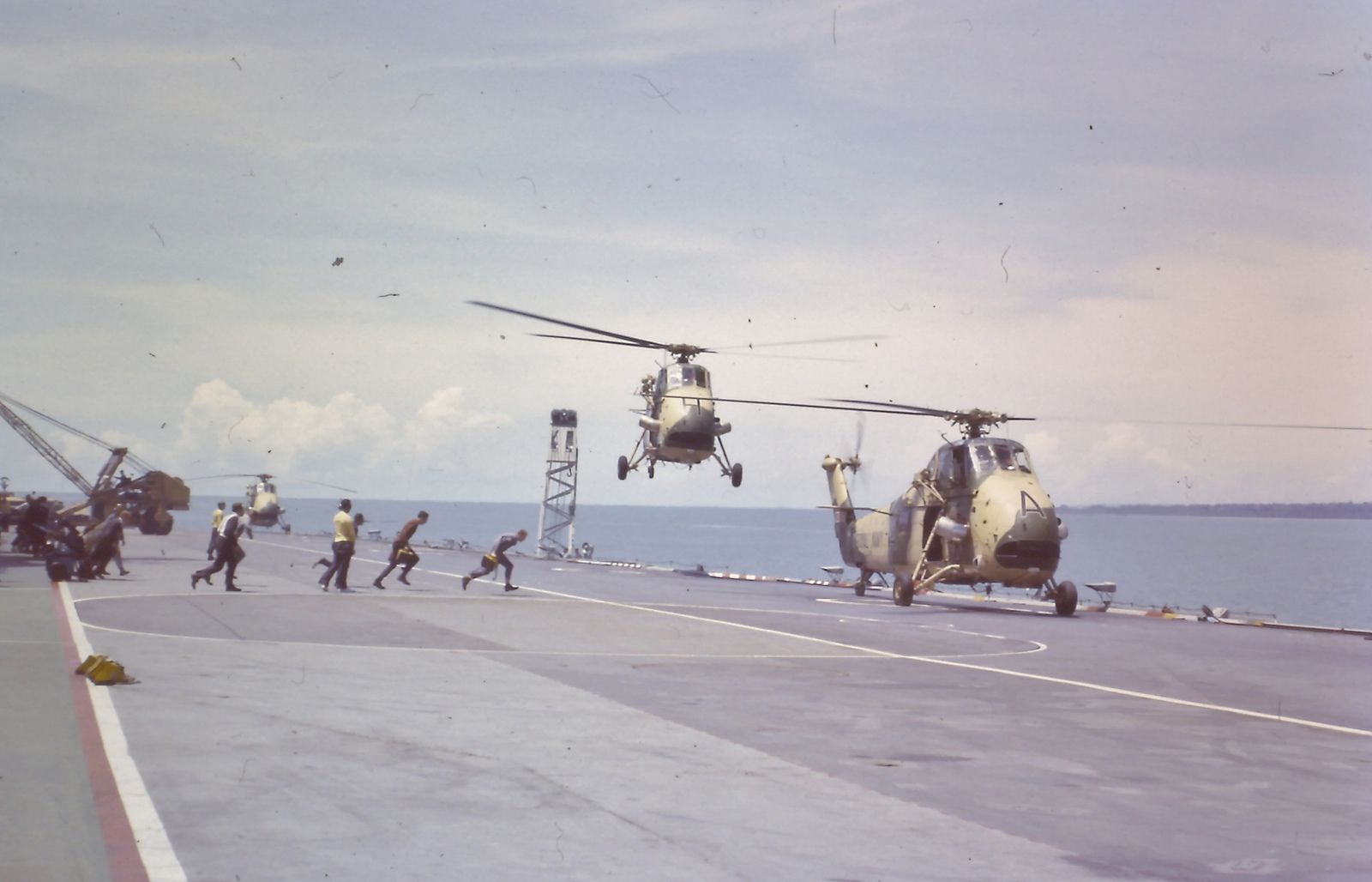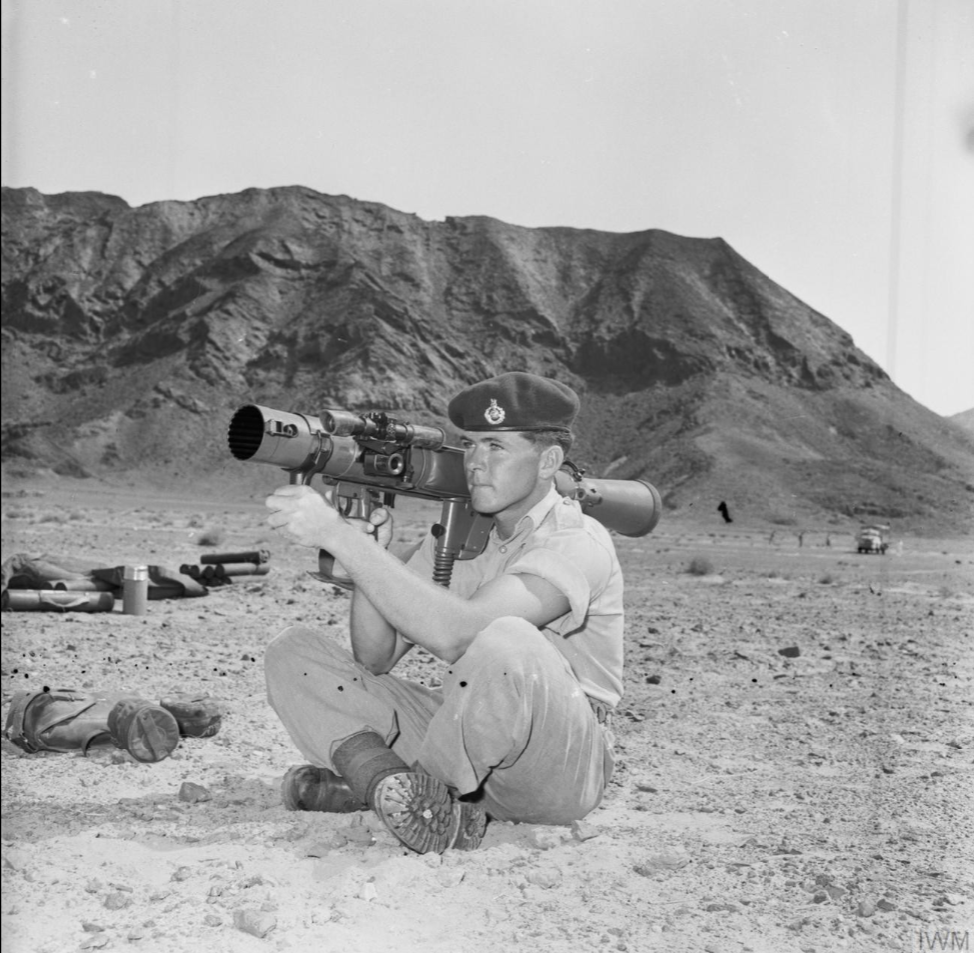| Golden Journal No. 32:
Four-Five Commando
East of Suez
By Mike Bennighof, Ph.D.
May 2020
Hong Kong is up for grabs
London is full of Arabs
We could be in Palestine
Overrun by a Chinese line
With the boys from the Mersey and the Thames and the Tyne
- Elvis Costello
The United Kingdom’s economy ended the Second World War at a state of near-collapse. The Empire claimed a place equal to those of the United States and the Soviet Union in the post-war international order, but it was a hollow boast.
Rationing continued until 1954 while the new Labour government, elected in a 1945 landslide, embarked on an ambitious series of social programs including huge new housing construction projects and the National Health Service. At the same time, the Atlee government attempted to maintain a large military with world-wide commitments, consuming 7.7 percent of gross national product.
Britain received the largest Marshall Plan outlay, and an even larger loan from the United States. Rather than put these funds into industry and infrastructure, as was done by other recipients, the British used them to subsidize their outsize budgets. Economic growth did not begin in earnest until the 1950’s, helped in large part by steady trimming of the bloated military. Even so, Britain steadily fell behind West Germany and France in relative economic terms, countries that had poured their smaller Marshall Plan allotments into rebuilding the underpinnings of their economies.
While Britain’s military strength waned - the Royal Navy remained dependent on ships built or laid down during the Second World War - her commitments remained. British troops participated in the Korean War alongside the Americans, but also in Malaysia (the Malayan Emergency of 1948-60, and the Confrontation with Indonesia from 1962 to 1966), the 1956 Suez Crisis, Kenya (the Mau Mau Rebellion), the Cyprus Emergency (1955-59), the Dhofar Rebellion in Oman (1962-1975) and the Aden Emergency (1963-67). Labour Prime Minister Harold Wilson resisted American President Lyndon Johnson’s repeated demands for British troops to fight in Vietnam, “even a platoon of bagpipers,” but Royal Air Force planes did conduct secret missions over Laos.
To project power, Britain relied on two Royal Navy capabilities: the fleet of three aircraft carriers (plus a light carrier nominally considered a fleet asset as well), and the pair of amphibious warfare groups. One carrier and one amphibious group would be stationed in the Far East, and another in European waters, and third carrier task force would be at home for training and re-fitting.

Westland Wessex helicopters aboard HMS Albion.
The amphibious groups each consisted of a “commando carrier” and an amphibious assault ship, plus escorts. The aging light carriers Bulwark and Albion were refitted for the role, each carrying one Royal Marine commando (as the Marines style their battalions) and sixteen Westland Wessex helicopters to land them. The Empire could still put boots on the ground across a huge swath of the Earth’s surface, but that time was already coming to an end.
Britain’s carrier fleet had reached the end of its useful service life. The two fleet carriers Ark Royal and Eagle underwent extensive reconstruction in the early 1960’s aimed at enabling them to operate the American-made Phantom II jet fighter. The smaller Victorious had been totally reconstructed in the 1950’s, but while she could launch and recover the Phantom (proven in trials with an American plane loaned by the carrier Ranger) she could not operate a useful number of them.
The Royal Navy proposed a class of four new 54,000-ton fleet carriers to replace all four existing flattops. This CVA-01 design could operate all of the latest jets, both the Phantom for fleet air defense and the British-made Blackburn Buccaneer S.2 nuclear-capable strike plane, plus a handful of search aircraft ad air-sea rescue helicopters. The ships would be conventionally powered, with the first to be ordered in 1963. The plan included eight units of a new cruiser-sized air-defense destroyer, the Type 82 or Bristol class, and a pair of helicopter cruisers intended for anti-submarine defense of carrier groups.
The new Labour government elected in 1964 balked at the cost of the new carrier, but rather than cancel it outright the Wilson government insisted on a limit of 53,000 tons even as design improvement pushed the new carrier to a greater and greater tonnage. Scenting vulnerability, the Royal Air Force launched an effective campaign to scuttle not only the new carriers but the old ones as well. Land-based aircraft, the RAF argued, could provide all of the power projection Britain needed at a far lower cost, and could cover all British commitments from existing bases. To bolster their presentation, the RAF staffers moved Australia 500 miles westward to bring more of the Indian Ocean under coverage.

British carrier Victorious and Italian destroyer Intrepido at Malta, July 1967.
The 1966 White Paper issued by Secretary of State for Defence Denis Healey accepted the RAF arguments. The new carrier would be cancelled, but Ark Royal and Eagle would receive even more modernization despite their corroded war-built hulls. Supplementary papers issued in 1967 and 1968 cut back the force even more. A minor fire aboard Victorious provided the excuse to send her to the breakers, while the light carrier Hermes would be converted to a Commando carrier. Seven of the Type 82 destroyers were cancelled, while the helicopter cruiser survived to be re-designed as the Invincible-class “through-deck cruiser.”
Yet the RAF did not have the opportunity to savor its victory. The BAC TSR-2 long-range strike aircraft, cancelled in 1965, was not restored to the defense budget and its replacement, the American-made F-111, was cancelled. The Royal Navy counter-attacked and outflanked the RAF, seizing the nuclear deterrence role from the long-range bombers for a new class of four Polaris-missile-equipped nuclear submarines.
The White Paper took aim not just at weapons systems, but at the rationale for their acquisition. The very idea of projecting British power around the Indian and Pacific Oceans came into question, and as the Americans pressed for a commitment to Vietnam the British simply left the entire theater, withdrawing their forces from “East of Suez.”
The name, taken from a Kipling poem, stuck but the British pulled back from more than just the Indian and Pacific Oceans. British forces left Aden in November 1967 and over the next several years abandoned bases in Singapore, Malaysia, Libya and Malta. They finally left Oman in 1976, completing the movement.

A Royal Marine of 45 Commando and his best friend Charlie G, Aden 1967.
With British armed forces now focused on their NATO role, the Royal Marines took on new missions to fight on the alliance’s northern flank alongside the Norwegians. The cuts continued, with one of the three Commandos disbanded in 1981 and the Commando carriers and assault ships placed on the block for disposal. The 1982 Falklands War brought a swift reversal; the Royal Navy cancelled the sale of the assault ship Fearless to Argentina and sent her to the Falklands loaded with troops instead.
The remaining two Commandos remain in service, despite the sale of the helicopter carrier Ocean to Brazil, and the Royal Navy has finally received a new pair of large, modern aircraft carriers. The possibility of world-wide commitments hasn’t ended, with British forces deployed in Iraq and Afghanistan for much of this century, regions definitely East of Suez.
Click here to join the Gold Club
See your Gold Club Insider newsletter for ordering information.
Sign up for our newsletter right here. Your info will never be sold or transferred; we'll just use it to update you on new games and new offers.
Mike Bennighof is president of Avalanche Press and holds a doctorate in history from Emory University. A Fulbright Scholar and NASA Journalist in Space finalist, he has published over 100 books, games and articles on historical subjects.
He lives in Birmingham, Alabama with his wife, three children and his dog, Leopold. Leopold approves of this message.
|
